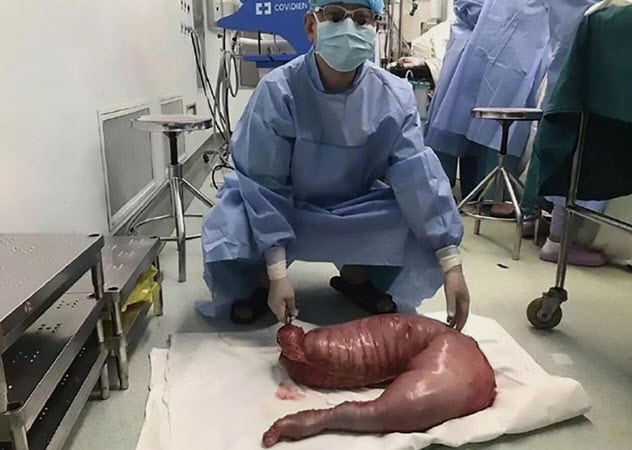 Politics
Politics  Politics
Politics  Weird Stuff
Weird Stuff Ten Bizarre Facts About The Doge Meme
 Our World
Our World 10 Ways Your Christmas Tree Is More Lit Than You Think
 Movies and TV
Movies and TV The 10 Coolest Stars to Set Sail on The Love Boat
 History
History 10 Things You Didn’t Know About the American National Anthem
 Technology
Technology Top 10 Everyday Tech Buzzwords That Hide a Darker Past
 Humans
Humans 10 Everyday Human Behaviors That Are Actually Survival Instincts
 Animals
Animals 10 Animals That Humiliated and Harmed Historical Leaders
 History
History 10 Most Influential Protests in Modern History
 Creepy
Creepy 10 More Representations of Death from Myth, Legend, and Folktale
 Politics
Politics 10 Political Scandals That Sent Crowds Into the Streets
 Weird Stuff
Weird Stuff Ten Bizarre Facts About The Doge Meme
 Our World
Our World 10 Ways Your Christmas Tree Is More Lit Than You Think
Who's Behind Listverse?

Jamie Frater
Head Editor
Jamie founded Listverse due to an insatiable desire to share fascinating, obscure, and bizarre facts. He has been a guest speaker on numerous national radio and television stations and is a five time published author.
More About Us Movies and TV
Movies and TV The 10 Coolest Stars to Set Sail on The Love Boat
 History
History 10 Things You Didn’t Know About the American National Anthem
 Technology
Technology Top 10 Everyday Tech Buzzwords That Hide a Darker Past
 Humans
Humans 10 Everyday Human Behaviors That Are Actually Survival Instincts
 Animals
Animals 10 Animals That Humiliated and Harmed Historical Leaders
 History
History 10 Most Influential Protests in Modern History
 Creepy
Creepy 10 More Representations of Death from Myth, Legend, and Folktale
10 Cases Of Bizarre Medical Ailments
Medical dramas are spreading across US television networks like wildfire. From Chicago Med to The Good Doctor, it would seem that people yearn to understand the complex and fragile nature of the human body.
Through the power of television, we are given a glimpse of the mysterious world beneath our own skin. We learn about what happens when these processes start to unravel, feeding our fascination with sickness and mortality.
While the body remains a remarkable feat of evolution—having adapted to a range of climates, diets, and activities—it is not without its weaknesses. Sometimes, the immune system goes haywire, the pumping power of the heart dwindles, or genetic mutations corrupt some vital aspect of our metabolism.
But every once in a while, disease does something to the body so rare that it warrants special attention. Without further ado, we’ll take a look at 10 fascinating cases of bizarre medical ailments.
10 Drunk On Carbs

Every morning, Nick Hess would wake up and vomit. The 35-year-old experienced a number of unexplained symptoms, including stomach pains, nausea, and headaches. Hess frequently found himself intoxicated without a drop of alcohol passing his lips. “Sometimes, it would come on over the course of a few days; sometimes, it was just like ‘bam! I’m drunk,’ ” said Hess.[1]
His wife initially suspected that he was an alcoholic in denial. Karen Daws searched their family home for a secret stash of booze but came up empty. Although Nick was subjected to a battery of medical tests, doctors remained baffled by their patient’s condition.
Through Karen’s own research, the Ohio couple eventually made contact with Dr. Anup Kanodia. After taking stool and blood samples, Kanodia discovered that Nick’s gut had around 400 percent more yeast than normal.
It turned out that Nick had a condition called auto-brewery syndrome. A particular type of yeast (Saccharomyces cerevisiae) in Nick’s gut was responsible for excessive fermentation of carbohydrate-rich meals. The resultant alcohol was then absorbed across the intestine, thereby raising his blood alcohol levels.
While auto-brewery syndrome is an established condition, there remains much debate over whether the amount of alcohol produced in the gut can lead to any significant intoxication. Over the years, a number of individuals accused of drunk driving have used auto-brewery syndrome as part of their defense.
In 2015, charges of drunk driving against a New York woman were dropped after it emerged that she was suffering from auto-brewery syndrome. Anup Kanodia was asked to test the woman’s blood alcohol levels. The woman was monitored for an entire day to ensure that she could not consume any alcohol. By the end of the testing period, it was discovered that she had a blood alcohol content of 0.36—over four times the legal limit for driving.
As for Nick, he currently takes antifungal tablets to control the yeast levels in his gut. He also adheres to a low-carbohydrate, low-yeast diet.
9 Hyperekplexia

Also known as “exaggerated surprise,” hyperekplexia is an inherited disorder that causes an increase in muscle tone. The most obvious symptom of this rare disease is something called “excessive startle reflex.” Sufferers appear to overreact to simple surprises, leading to exaggerated movements. This is then followed by a brief moment of rigidity, where the patient cannot move at all.
It is estimated that 1 in 40,000 people in the United States have hyperekplexia. Researchers believe that genetic hyperekplexia is the result of mutations in certain receptors of the brain stem. These mutations prevent the normal “dampening” signals that would otherwise lessen the startle reflex.
The condition presents considerable danger to newborn babies as the startle reflex can cause breathing problems. This certainly remains the case for one British boy, Jacob Madgin. As a baby, Magdin’s condition was so severe that he needed to be fed through a tube. The mere touch of a teat against the boy’s nose was enough to trigger a spasm that interrupted his breathing.
From the sound of a dog barking to the splash of water, almost anything can set off an episode. “You never know what might trigger Jacob’s condition. When I was opening a box of blueberries, the noise of the plastic as I opened the lid set him off,” explained the boy’s mother.[2]
8 Phantom Rectum Syndrome

Sometimes, surgeons are tasked with bypassing part of a patient’s diseased or injured intestine. To do this, the healthy part of the intestine is cut away from the diseased part and redirected through the abdomen. Waste matter passes through this opening, called a stoma, and is collected in a colostomy or ileostomy bag. As a result of stoma surgery, feces no longer reach the rectum.
Some stoma patients keep their rectums. In this case, the bowel continues to create a lubricant that is supposed to help with the movement of food. When there is no passage of food, however, this mucus can sometimes form a dry, painful ball that needs to be passed.
Patients who have had their rectums removed may also feel the urge to defecate—an experience known as phantom rectum syndrome. Many have reported feeling the need to pass gas (phantom flatus) and feces (phantom feces). Phantom pain of the region is associated with burning, stinging, and pins and needles.
In 2013, BBC presenter Sam Cleasby underwent an operation to have part of her colon removed after suffering for years with ulcerative colitis. She is now on a mission to spread awareness of stomas and break down the stigma surrounding the use of stoma bags.
Sam has previously spoken about what phantom rectum syndrome feels like: “People who have lost a limb still feel pain or itching, or they feel like their limb’s still there. [ . . . ] So that’s the same but in your rectum. It’s like your brain doesn’t know that it’s not attached anymore.”[3]
7 Sweating Blood

In 2017, an Italian woman was admitted to the hospital with one horrifying symptom: spontaneous bleeding of the palms and face. The episodes would last up to five minutes and could strike at any moment. The 21-year-old struggled for three years before finally seeking medical attention. Understandably, the woman felt self-conscious about her ailment. She shut herself away from the rest of the world and started to develop the telltale signs of depression and panic disorder.
Doctors initially suspected their patient of having factitious disorder—a mental health issue in which a patient attempts to fake a medical condition, usually in a bid to receive attention or sympathy. Factitious disorder is not uncommon, costing the US around $40 million every year.
However, it quickly became apparent that the woman was not self-harming. Doctors witnessed firsthand the “discharge of bloodstained fluid” from the woman’s forehead and lower face.[4]
The team eventually diagnosed the woman with hematohidrosis. Although the exact cause of the disease remains a mystery, the condition often occurs in patients who are under extreme emotional or physical stress. The tiny capillaries that supply blood to the sweat glands are said to rupture and leak. The blood then enters the sweat glands, mixes with sweat, and oozes its way to the skin’s surface.
Cases of hematohidrosis have been documented in people with acute fear. The phenomenon may even date back to the time of Jesus Christ. The day before his crucifixion, Christ prayed in the Garden of Gethsemane. According to Luke’s Gospel, a rather anxious-looking Jesus produced “great drops of blood” that fell to the ground.
6 Hirschsprung’s Disease

In 2017, surgeons in China removed around 76 centimeters (30 in) of a patient’s colon. Prior to surgery, 22-year-old Zhou Hai’s abdomen had ballooned to such an extent that he looked heavily pregnant. Contained within the resected bowel was an astonishing 13 kilograms (29 lb) of feces.
Doctors soon discovered the source of the problem: a rare congenital disorder called Hirschsprung’s disease.
The patient had struggled with constipation since he was born, with laxatives doing little to alleviate the symptoms. It turned out that this constipation stemmed from an absence of nerves along parts of his large intestine.
Typically, the entire stretch of bowel receives signals from a large network of nerves. Nervous impulses trigger the rhythmic contraction and relaxation of the bowel’s muscle, thereby pushing the feces toward the rectum. In patients with Hirschsprung’s disease, the absence of some of these nerves disrupts this movement, causing feces to accumulate and form a blockage.
Zhou Hai’s blockage had been left for so long that the resultant backlog of feces was stopping him from breathing properly. He also complained of severe abdominal pain—which was understandable considering the weight he was lugging around.
Surgeons at the Tenth People’s Hospital in Shanghai removed the affected portion of Hai’s bowel. As part of the three-hour-long procedure, the healthy part of Hai’s bowel was reattached to his anus.[5]
5 Gluten Psychosis

Most people have heard of celiac disease. It occurs when a person’s immune system is primed to a specific structure found in wheat. This ultimately causes the cells of the immune system to target the small intestine. If left untreated, the tissues of the gut become damaged, impairing the ability of the intestine to absorb vital nutrients.
The most common symptoms of celiac disease include gas, abdominal pain, weight loss, diarrhea, and constipation. However, in very rare instances, the condition has been known to play tricks on the mind.
In 2016, doctors were baffled when a 37-year-old student presented with a series of unusual symptoms. The woman thought that her friends and family were conspiring against her as part of an elaborate “game.” Then she mistakenly accused her mother and father of burglarizing her apartment. After issuing a series of threats to her loved ones, the woman was admitted to a psychiatric hospital.
The patient’s iron levels had plummeted, and she was deficient in a number of vitamins. She also underwent extreme weight loss, despite having an increased appetite. The doctors initially diagnosed her with paranoid schizophrenia.[6]
She was eventually discharged with antipsychotic medications along with multivitamins and minerals. But the treatment was unsuccessful. The woman’s psychosis persisted, and she continued to lose weight.
The doctors eventually discovered the reason for the patient’s psychotic breakdown: celiac disease. While most cases of celiac disease manifest in symptoms of the digestive tract, around a fifth of patients experience neurological and psychiatric problems.
The destructive immune cells are usually isolated within the gut. But if they migrate to the central nervous system, patients can experience a range of psychiatric issues, including memory loss, hallucinations, and seizures.
The woman refused to adhere to a wheat-free diet, thinking the doctors were working against her best interests. Her condition rapidly deteriorated. She lost her job, became homeless, and tried to commit suicide. She was eventually rehospitalized and placed on a wheat-free diet.
After mere months of treatment, the woman’s psychosis disappeared and her life started to return to normal. Unfortunately, in a moment of extreme carelessness, she accidentally started consuming wheat again. She suffered yet another psychotic episode and was put in jail for trying to murder her parents.
4 Persistent Genital Arousal Disorder
A&E nurse Kim Ramsey used to have up to 100 orgasms a day. This continuous state of arousal started in 2001 after the 46-year-old fell down a flight of stairs. Since that day, Ramsey has struggled with a condition known as persistent genital arousal disorder (PGAD).[7]
PGAD is an unwanted, uncontrollable feeling of genital arousal that can last for hours or days. The condition mostly affects women, but a few cases have been documented in men. While PGAD remains poorly understood, researchers think the disease is rooted in psychological, neurological, and vascular problems.
Many PGAD sufferers feel like they are constantly on the verge of orgasm, with symptoms often manifesting in public places. Arousal is sometimes accompanied by pelvic pain and discomfort. For Kim, avoiding certain triggers helps to lessen her symptoms. She also tries to keep herself distracted with work.
A South Carolina resident, Heather Dearmon, started experiencing similar symptoms during her pregnancy. The 34-year-old hoped the problem would go away after giving birth to her son. But the problem persisted for years, and her symptoms became more frequent.
Dearmon would masturbate to three consecutive orgasms to alleviate her symptoms. “To achieve three consecutive orgasms takes a long time. I felt my whole life being robbed,” she explained. Even trips in the car would trigger her arousal.
Due to the embarrassing nature of PGAD, many women report feeling suicidal and depressed. In 2012, Gretchen Molannen committed suicide after living with PGAD for 16 years. Before her death, Molannen described one of her worst experiences: “I had not had medical treatment yet or any kind of medication. I had 50 orgasms in a row. In a row. Nonstop. I thought I was gonna die.”
There is no known cure for PGAD. However, the condition is often treated using medications, cognitive behavioral therapy, and pelvic floor therapy.
3 The Blue People Of Kentucky

During the 1960s, a hematologist and a nurse embarked upon a rather bizarre adventure. They tasked themselves with finding the elusive “Blue People of Kentucky.” Ruth Pendergrass had first seen one of the blue people while she was working as a nurse at a clinic in Hazard, Kentucky.
“Her face and her fingernails were almost indigo blue. It like to scared me to death! [sic] She looked like she was having a heart attack,” Pendergrass said.[8]
Intrigued, Pendergrass decided to team up with hematologist Madison Cawein to work out what was going on. The pair scoured Troublesome Creek and Ball Creek where the blue people were known to live. But Pendergrass and Cawein came up empty.
One day, two blue siblings walked into Cawein’s clinic. “They were bluer’n hell,” he remarked. The doctor set to work figuring out what was wrong. He took blood samples from his new patients, Patrick and Rachel Ritchie. Then Cawein drove out to take blood samples from the pair’s relatives.
Cawein discovered that the blue people’s blood was lacking a key enzyme. The missing enzyme is usually found in red blood cells and is needed for converting blue methemoglobin into red hemoglobin. The Blue People’s condition (hereditary methemoglobinemia) meant that their red blood cells were oxygen poor, hence their bluish skin color.
Cawein’s research turned up a simple treatment: methylene blue. Within minutes of administering the treatment, the Blue People’s skin turned a normal pink hue. The case was solved.
But why were there so many blue people roaming the creeks of Kentucky?
Well, the condition dates back to 1820 when a blue-skinned Frenchman, Martin Fugate, settled in Troublesome Creek. In an incredible twist of fate, Fugate married a woman who also carried the recessive gene for methemoglobinemia.
A person only gets the disease when they inherit two faulty genes, one from each parent. As a result of their parents’ genetic makeup, four of the seven Fugate children inherited blue skin. Inbreeding between members of the Fugate family caused the condition to spread throughout the region.
2 Parry-Romberg Syndrome
Parry-Romberg syndrome is a rare disorder that causes the skin, muscle, and connective tissue of the face to atrophy. The atrophy mostly affects just one side of the face (hemifacial), resulting in a slightly droopy appearance. Parry-Romberg syndrome usually kicks off in childhood or adolescence and worsens over a period of many years. The traumatizing disease affects just 1 in 250,000 people.
In 2011, a British girl called Maha Asghar was diagnosed with Parry-Romberg syndrome. She was just three years of age when the right side of her face started slowly wasting away.
Changes to the tissue around the youngster’s right eye and ear mean that she will likely encounter problems with vision and hearing. She also suffers with debilitating pain which can last for several hours.
There is currently no treatment available from Britain’s National Health Service, so Asghar’s family hopes to get crowdfunding for surgery abroad. Patients with Parry-Romberg syndrome often travel to the United States where only two vascular surgeons have the skill required to perform the facial reconstruction technique.[9]
In 2011, a North Carolina girl’s face was saved by microvascular surgery. The pioneering surgeon, Dr. John Siebert, took tissue from underneath the girl’s arm and sculpted it into her face.
Very little is known about Parry-Romberg syndrome, but some researchers believe that it could be the result of autoimmunity, nerve problems, infection, or trauma.
1 Forever Young

Mario Bosco is a Hollywood actor in his forties. Despite his advancing years, the Brooklyn man is routinely mistaken for a 14-year-old boy. Bosco’s youthful looks and diminutive stature are caused by a condition known as panhypopituitarism.
Panhypopituitarism occurs when the pituitary gland fails to secrete the correct levels of hormones. The symptoms of the disease are dependent upon which hormones are deficient. As one might expect, decreased levels of growth hormone lead to delays in growth, whereas a decrease in gonadotropins causes stunted sexual development.[10]
Bosco spent much of his youth in and out of the hospital. He had severe medical issues when he was first born, including convulsions, low blood sugar, and thyroid problems. Bosco’s abnormal hormone levels meant that his body did not mature correctly. Today, he stands at just 147 centimeters (4’10”) and has the face and body of a wiry teenager.
Despite these challenges, Bosco went on to find fame as an actor. He has met many Hollywood stars and appeared on numerous television shows, including NYPD Blue and Jimmy Kimmel Live. “I feel like none of this would have happened if I hadn’t have looked and sounded different,” he said.
Read about more bizarre medical conditions on Top 10 Culture-Specific Illnesses And Mental Disorders and 10 Strange Psychological Disorders That Will Blow Your Mind.








